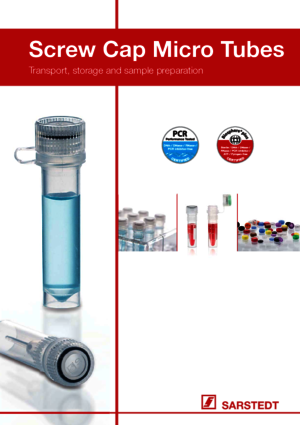
Screw Cap Micro Tubes
Screw Cap Micro Tubes
Language:
When we introduced the screw cap micro tubes about 35 years ago, we established a new class of safe screw cap tube which has proven its worth time and again. The particularly safe O-ring screw cap makes it a versatile piece of equipment. Ideal as a centrifuge tube, transport and storage tube, e.g. for high-grade synthesised oligonucleotides, enzymes and buffers. Clean room conditions, trained staff in protective clothing and automatic production processes are the prerequisites for the certified Sarstedt quality standards 'PCR Performance Tested' and 'Biosphere® plus'.

Screw cap micro tube, working volume: 0.5 ml, skirted conical base, with knurling, transparent, cap: natural, cap enclosed, 500 piece(s)/bag
Screw cap micro tube, working volume: 0.5 ml, skirted conical base, with knurling, transparent, cap: natural, cap enclosed, with printed writing space, 250 piece(s)/bag
Screw cap micro tube, working volume: 0.5 ml, skirted conical base, with knurling, transparent, cap: natural, cap enclosed, 100 piece(s)/bag
Screw cap micro tube, working volume: 0.5 ml, skirted conical base, with knurling, transparent, without cap, 500 piece(s)/bag
Screw cap micro tube, working volume: 0.5 ml, skirted conical base, with knurling, brown, cap: brown, cap enclosed, 500 piece(s)/bag
Screw cap micro tube, working volume: 0.5 ml, skirted conical base, with knurling, brown, without cap, 500 piece(s)/bag
Screw cap micro tube, working volume: 0.5 ml, skirted conical base, with knurling, transparent, cap enclosed, with printed writing space, 250 piece(s)/bag
Screw cap micro tube, working volume: 0.5 ml, skirted conical base, with knurling, transparent, cap: natural, cap enclosed, with printed writing space, sterile, 100 piece(s)/bag
Screw cap micro tube, working volume: 2 ml, skirted conical base, with knurling, black, without cap, 500 piece(s)/bag
Screw cap micro tube, working volume: 0.5 ml, skirted conical base, with knurling, transparent, without cap, 500 piece(s)/double bag

The total length including the cap is 46.0 mm, with the cap attached it is 49.0 mm. The diameter underneath the mounting bundle is 10.8 mm. This means they can be used in most common microcentrifuges without any problems.
Our screw cap micro tubes have been used at temperatures below zero centigrade for decades. Based on our general experience, the screw cap micro tubes can be used to freeze aqueous solutions at temperatures of up to -86°C, except in the case of demineralised water (purified water) solutions. With demineralised water, there are generally critical freezing situations which can lead to the formation of cracks. Here, successful freezing of the tubes is always dependent on many factors. These include the medium to be frozen, the rack used and the mechanical load on the tubes. The use of tubes at temperatures below zero centigrade should therefore be tested under the routine conditions of the user.
For cryopreservation, we recommend using Sarstedt's CryoPure tubes.
The torque for caps for machine tightening should be between 15 and 18 Ncm.
All micro tubes type A, C, E, G and I can be provided with a 25 x 21.5 mm label in the factory. Depending on the requirements, the label can be printed individually and with different colours. Labels with all common barcode types can also be printed.
Since the labels are exposed to different stresses depending on the application – temperature fluctuations, contact with liquids and/or chemicals – labels and printing inks made of various different materials are available. The minimum purchase volume is determined individually.
The shipping of samples on dry ice is a common method, but we are aware of some problems associated with this type of shipping. When shipping in this manner, it is necessary to ensure that the tubes are packed so that they are protected as well as possible and appropriately fastened to avoid damage.
Our micro tubes can be centrifuged up to 20,000 x g. Tested with density solution (density: 1.06 g/ml) filled up to a nominal volume, at 20°C for 15 minutes in the fixed-angle rotor.
Our SafeSeal reaction tubes can be centrifuged up to 30,000 x g (2.0 ml up to 25,000 x g). Tested with demineralised water (density: 1.06 g/ml) filled up to a nominal volume, at 20°C for 90 minutes in the fixed-angle rotor.
Standard reaction tubes can be centrifuged at up to 20,000 x g. Tested with demineralised water (density: 1.06 g/ml) filled to nominal volume, at 20°C for 15 min. in a swing-out rotor. Our SafeSeal reaction tubes can be centrifuged at up to 30,000 x g (2.0 ml at up to 25,000 x g).
Screw cap micro tubes and reaction tubes can be autoclaved at 121°C without any appreciable loss of mechanical properties. When doing this it is important not to screw on/push down the cap to seal it. The user must check whether other product characteristics are affected by autoclaving in terms of the desired use.


